
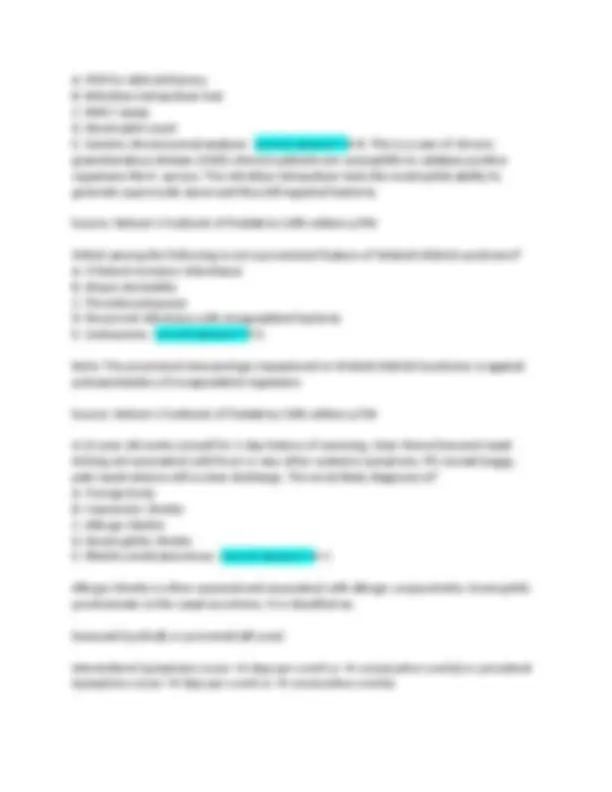
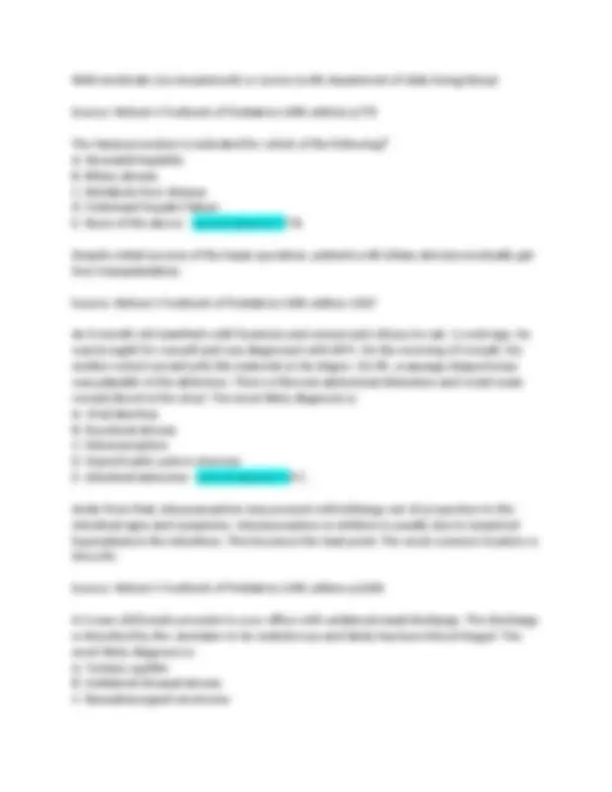
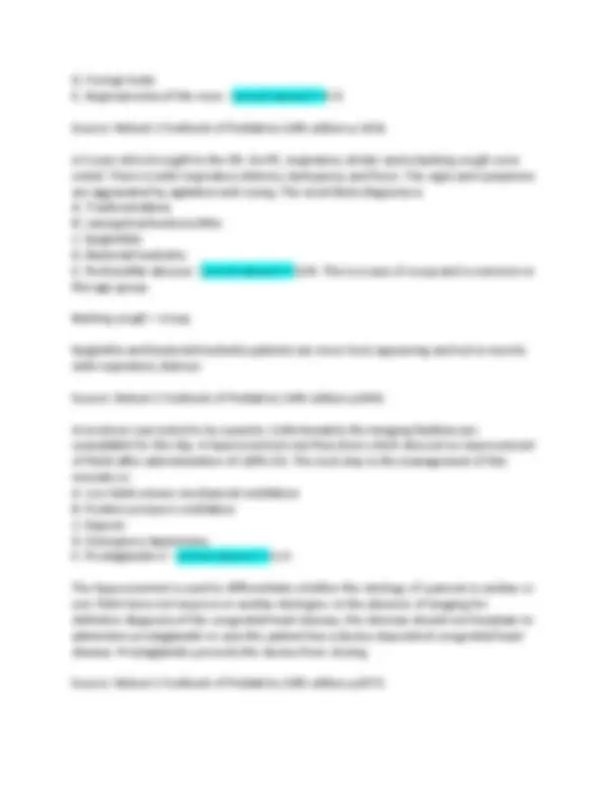



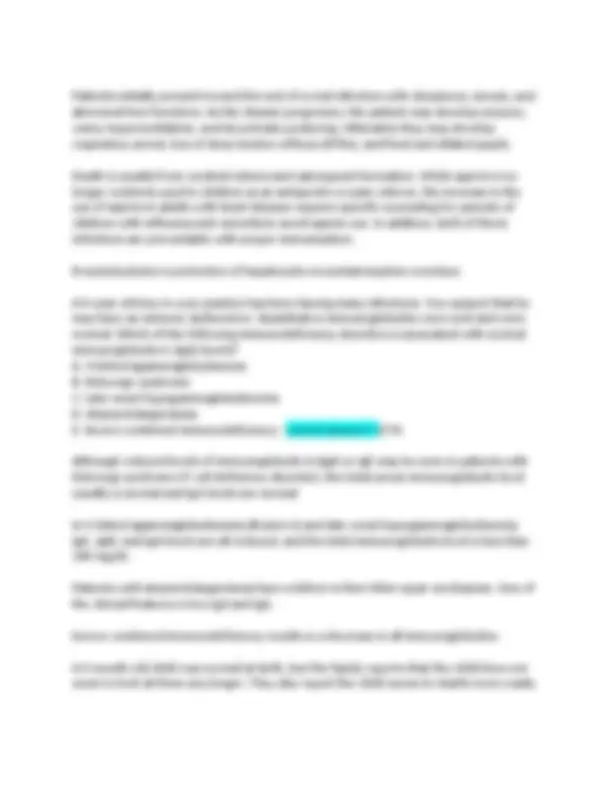
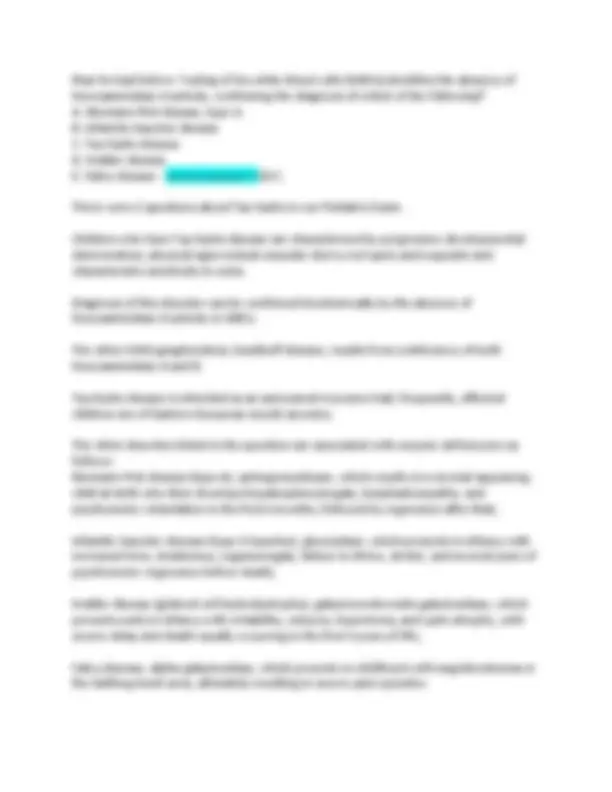
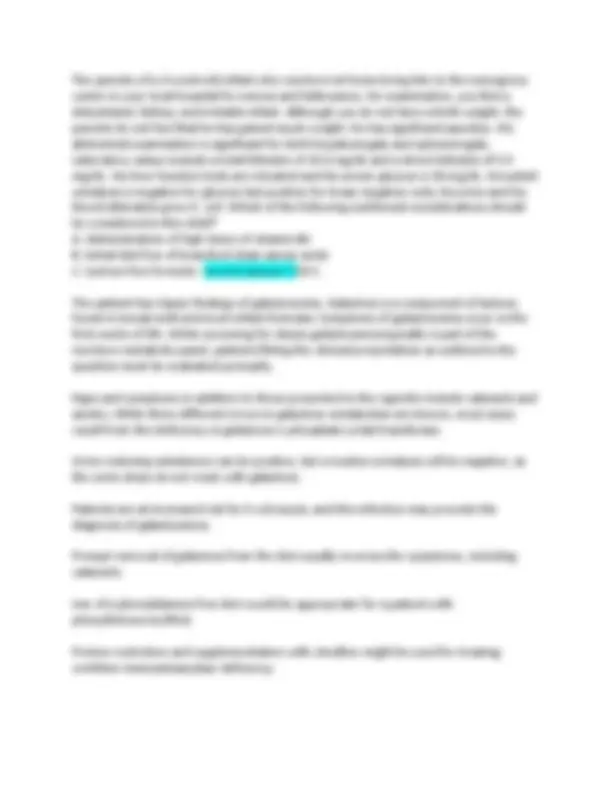
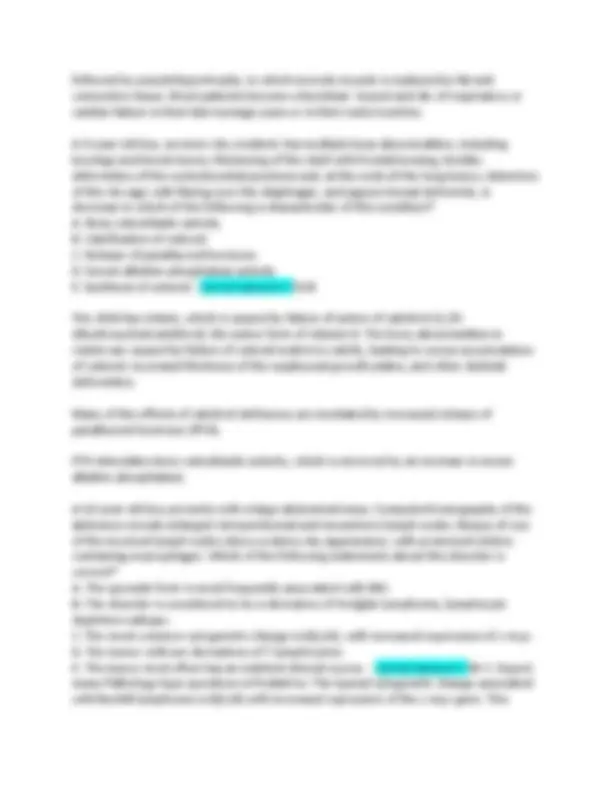
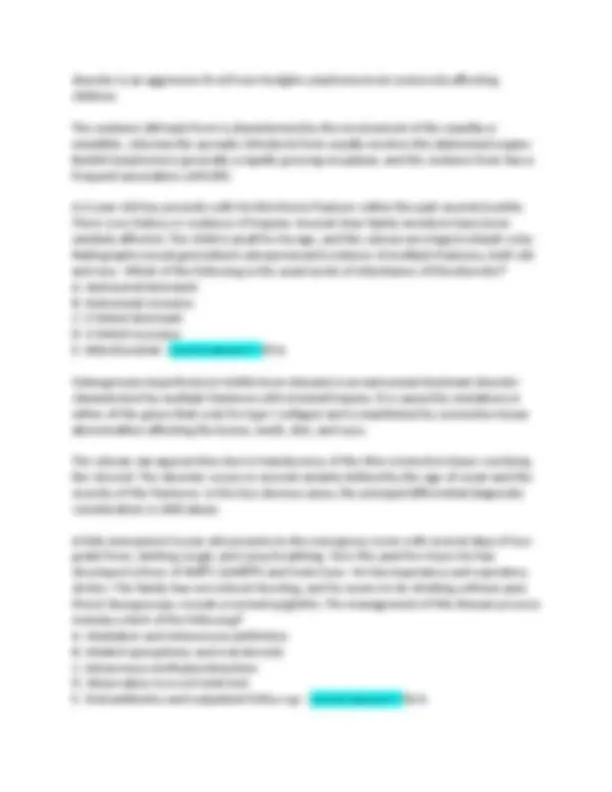
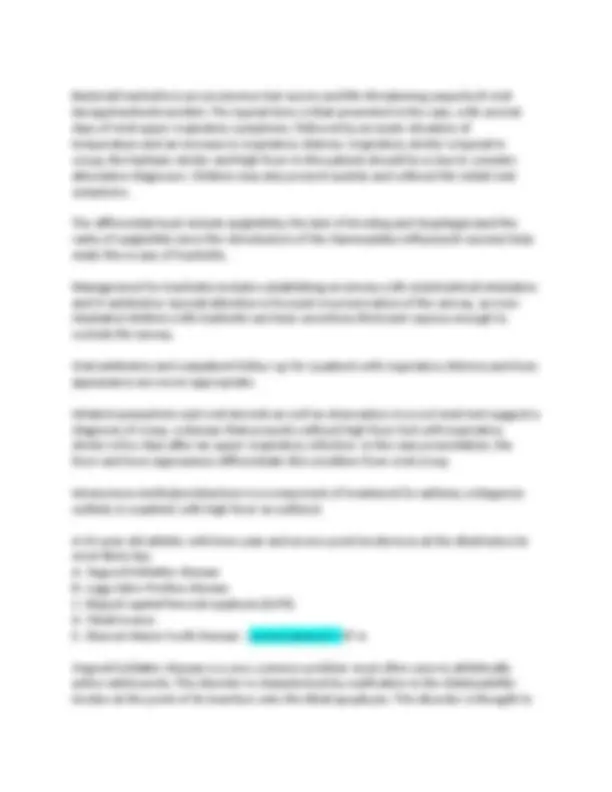

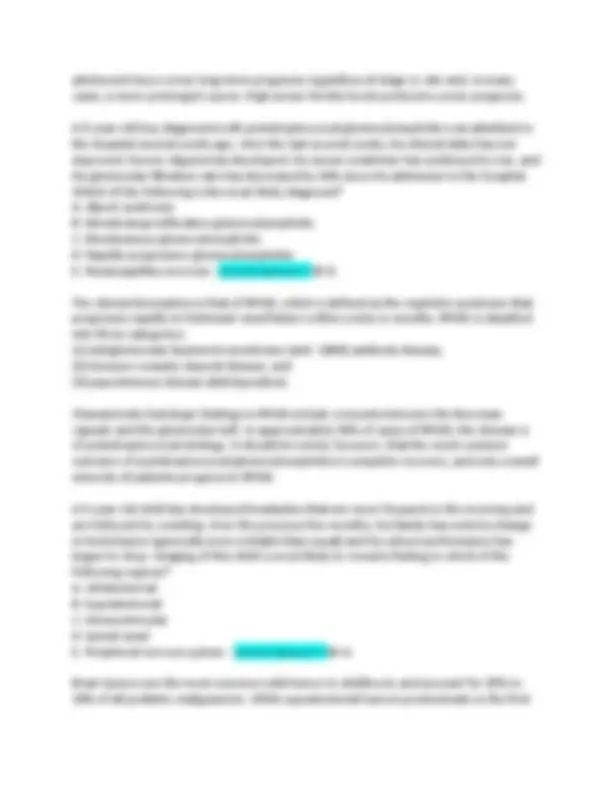


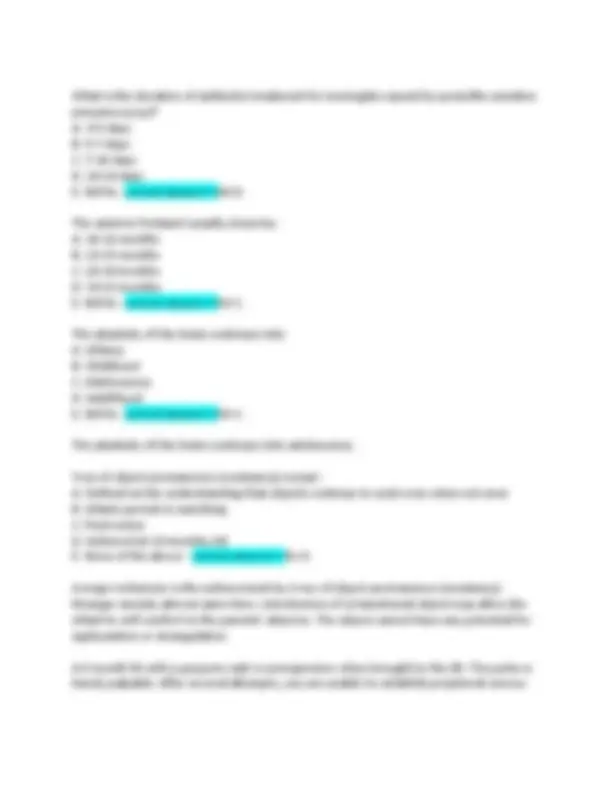

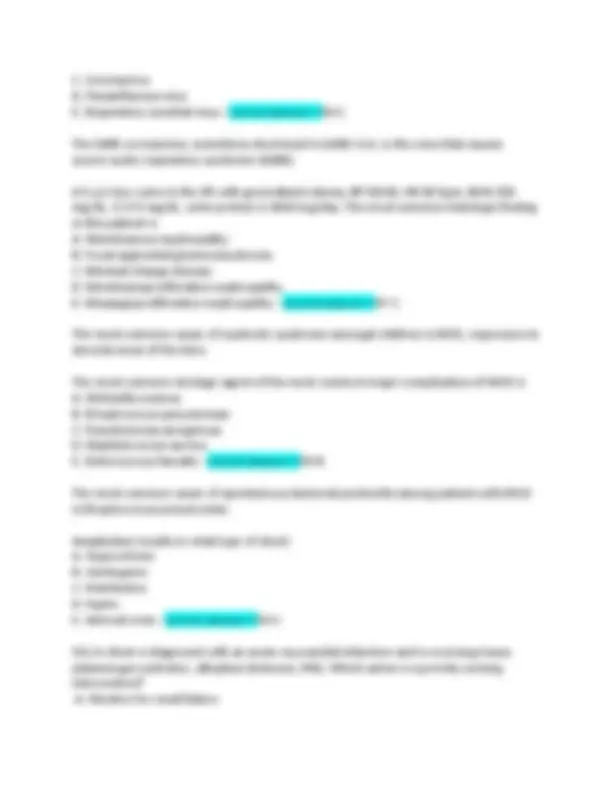
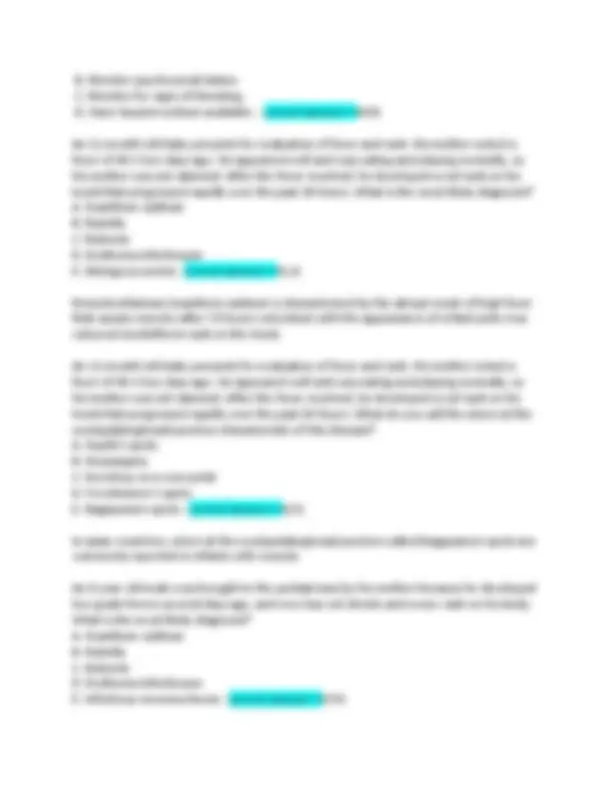



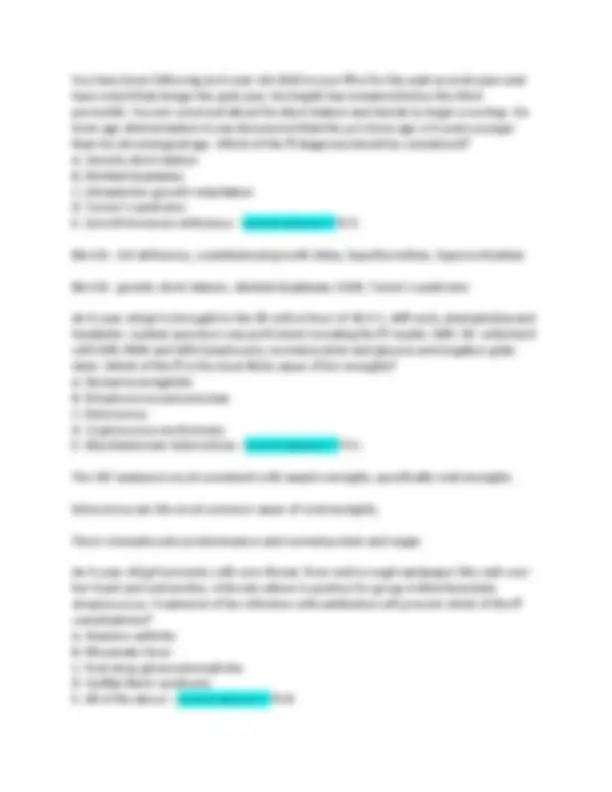
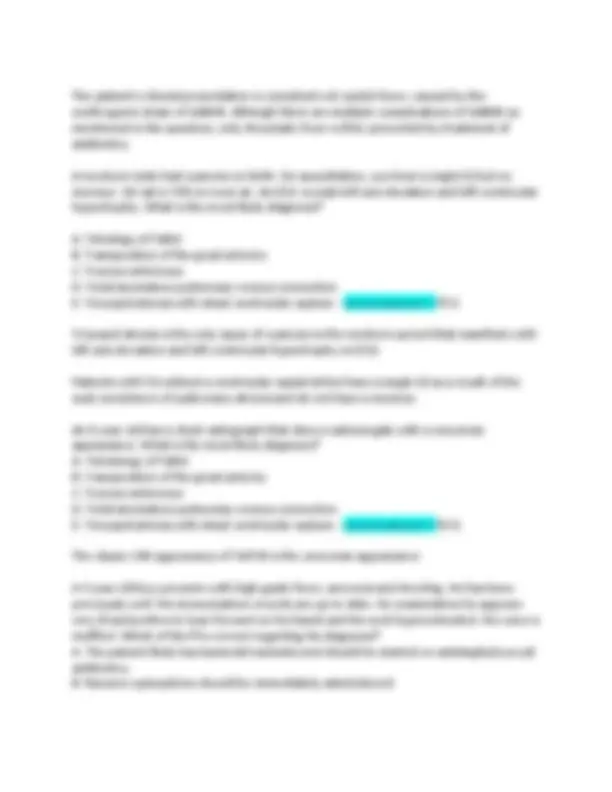
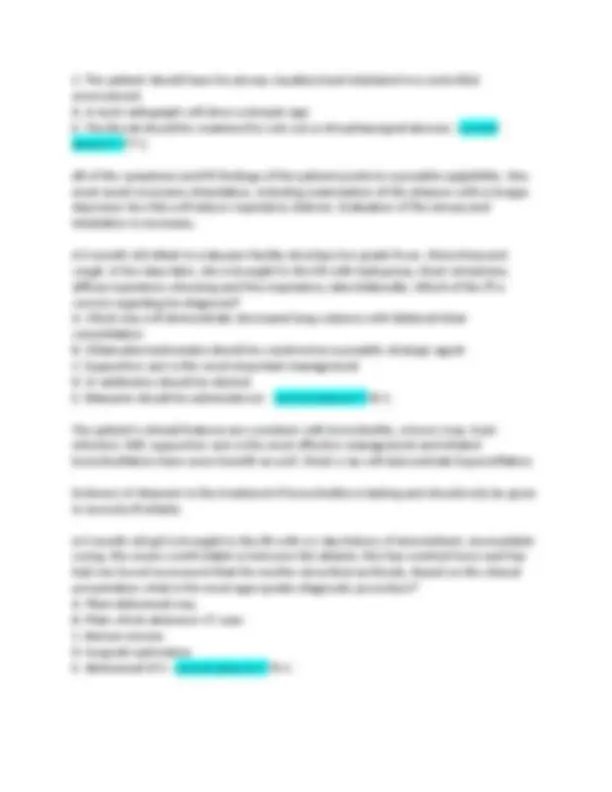
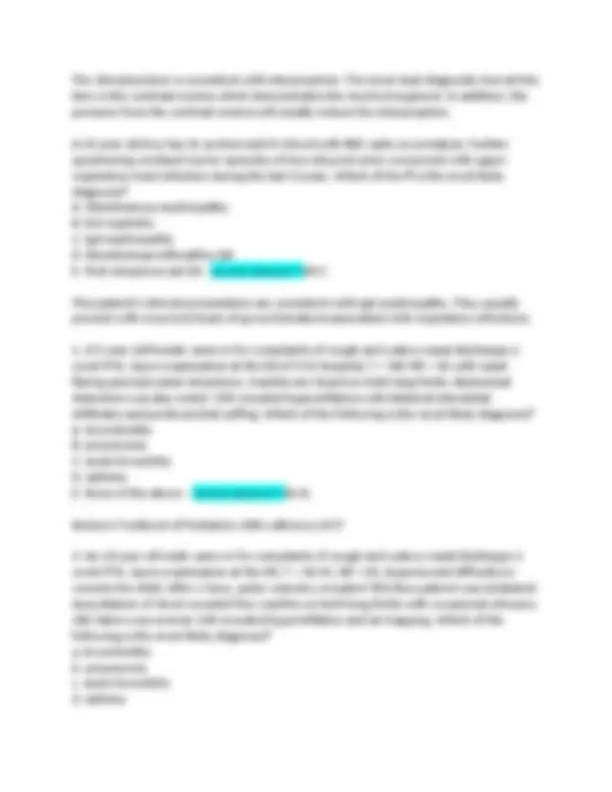
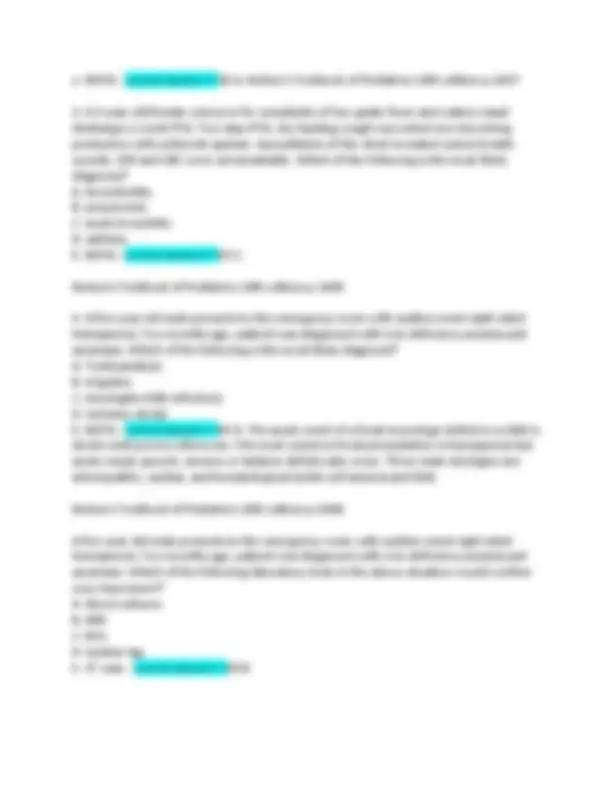
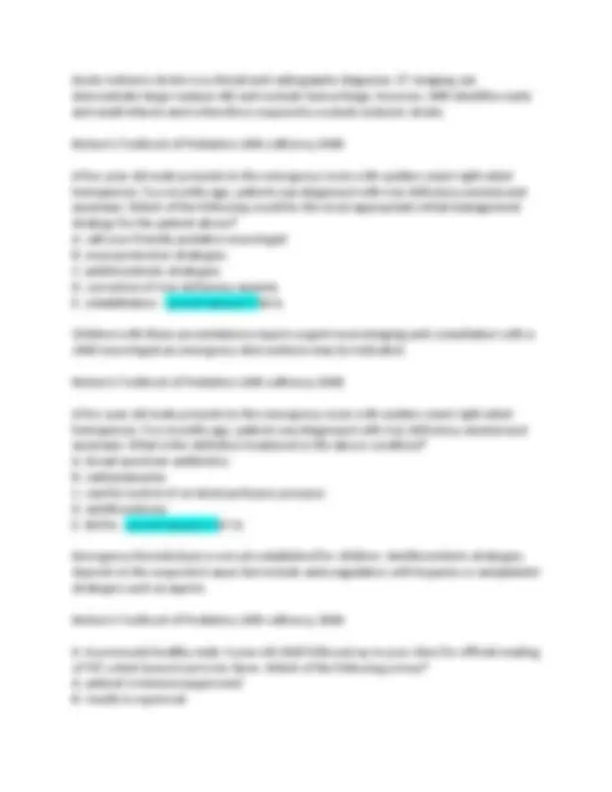


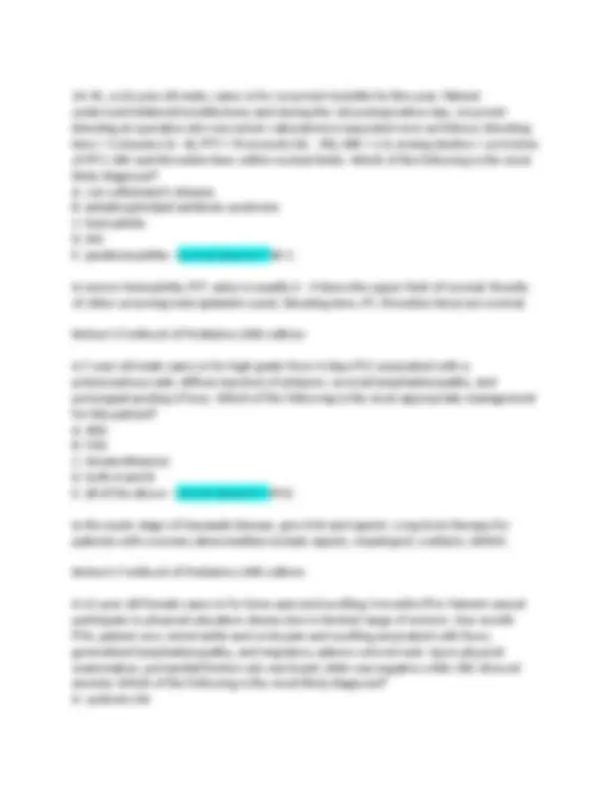
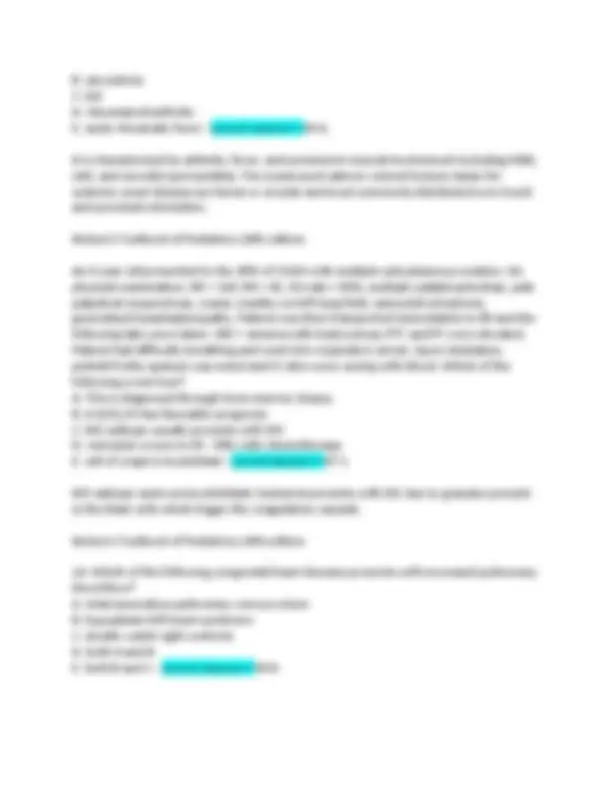
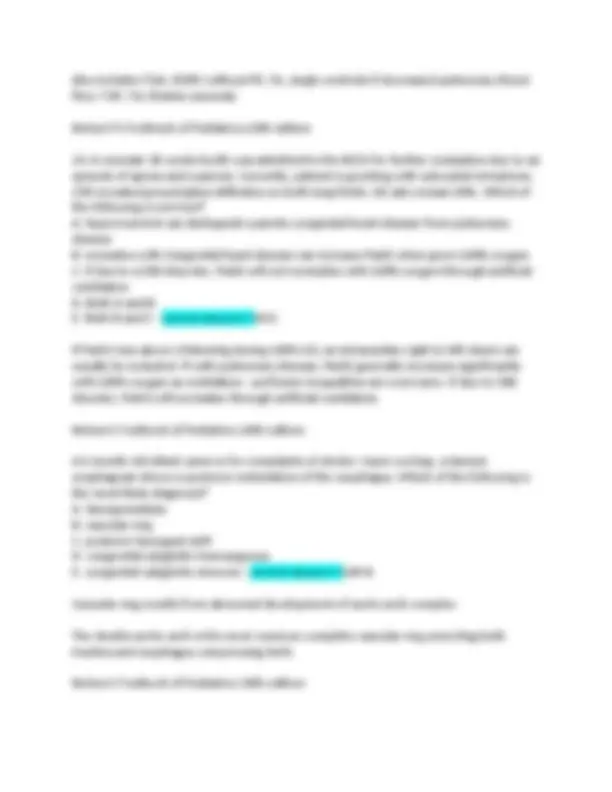
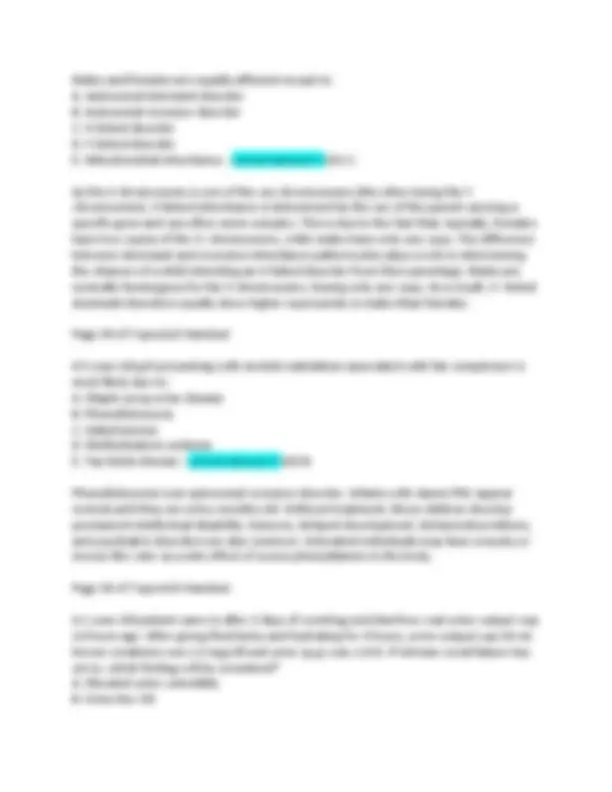
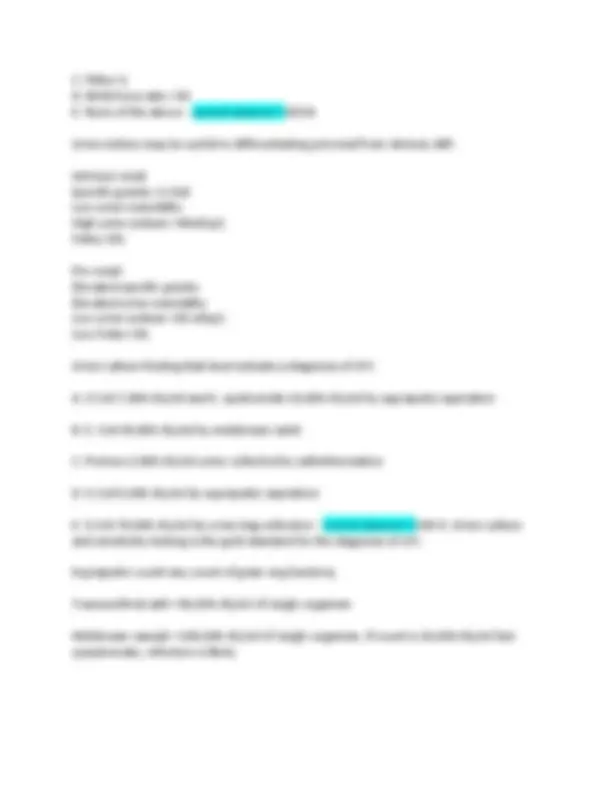
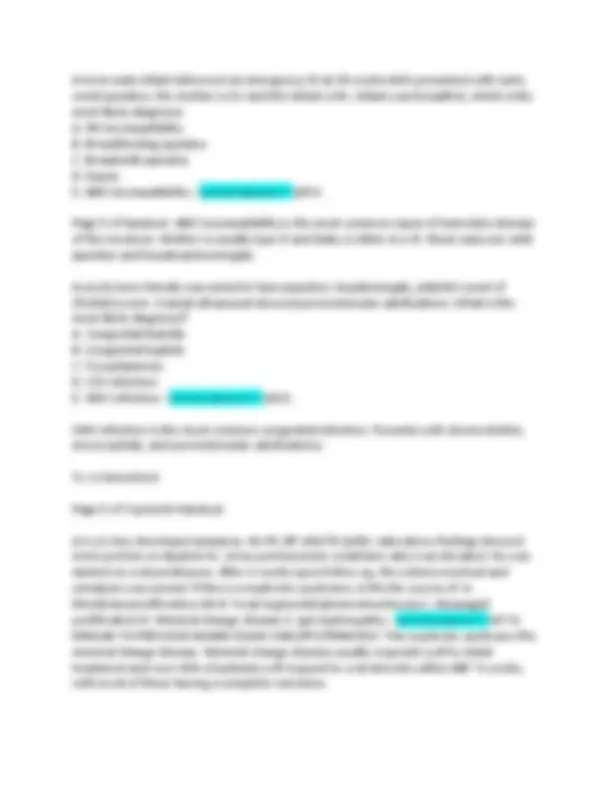





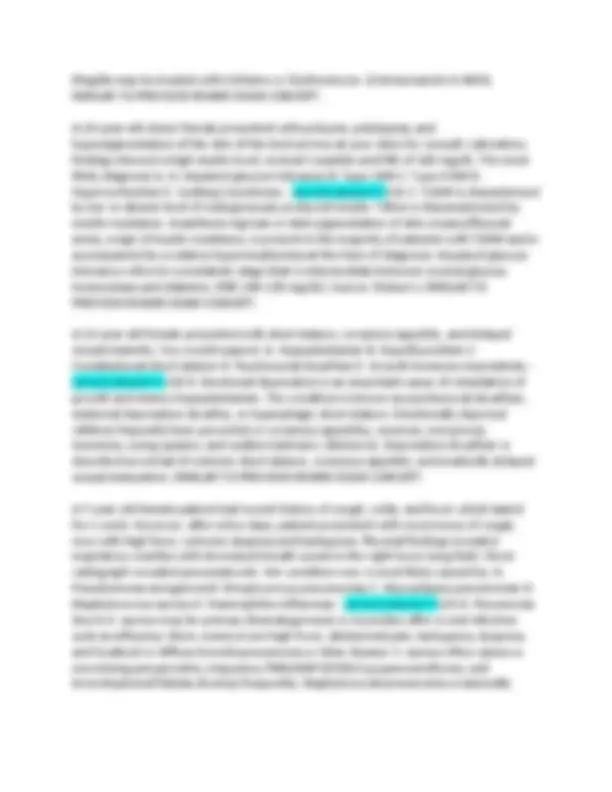

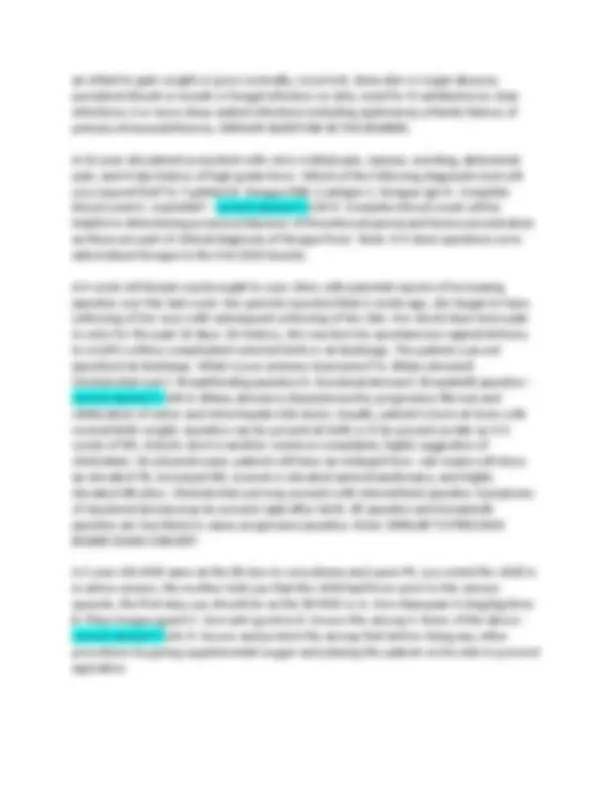
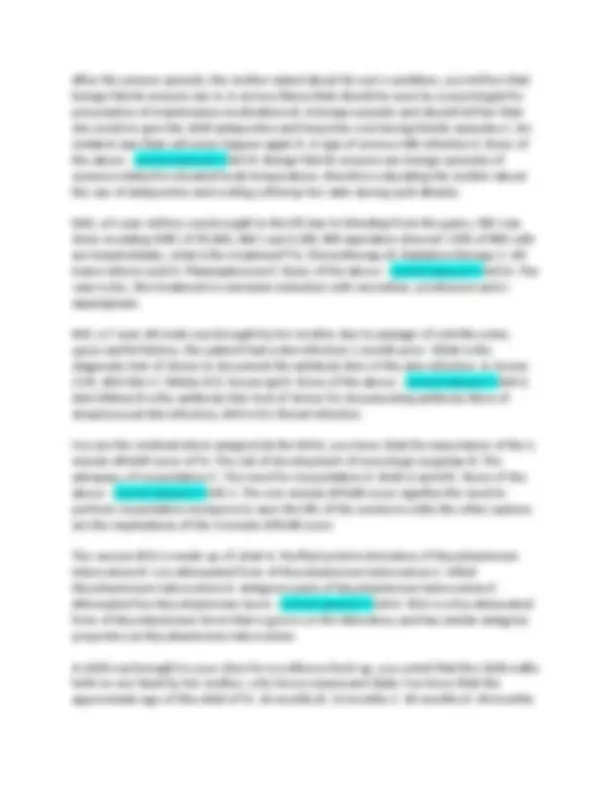
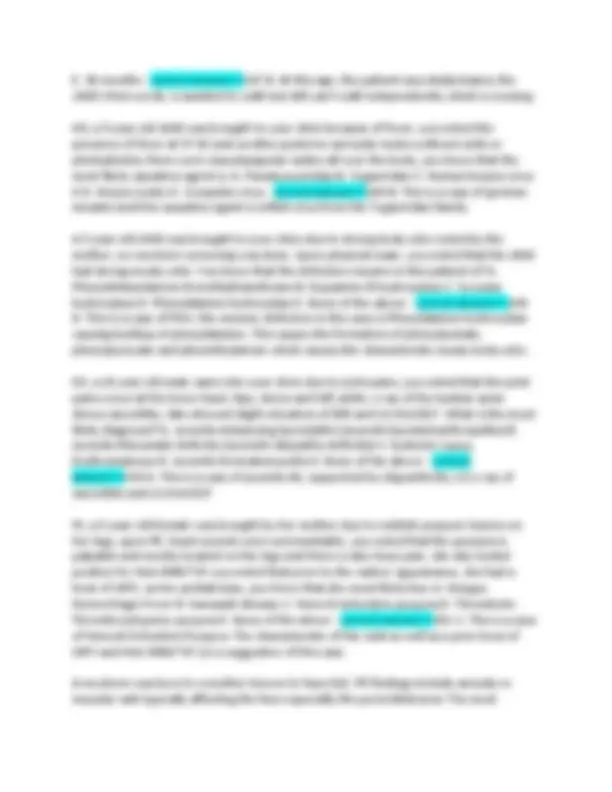







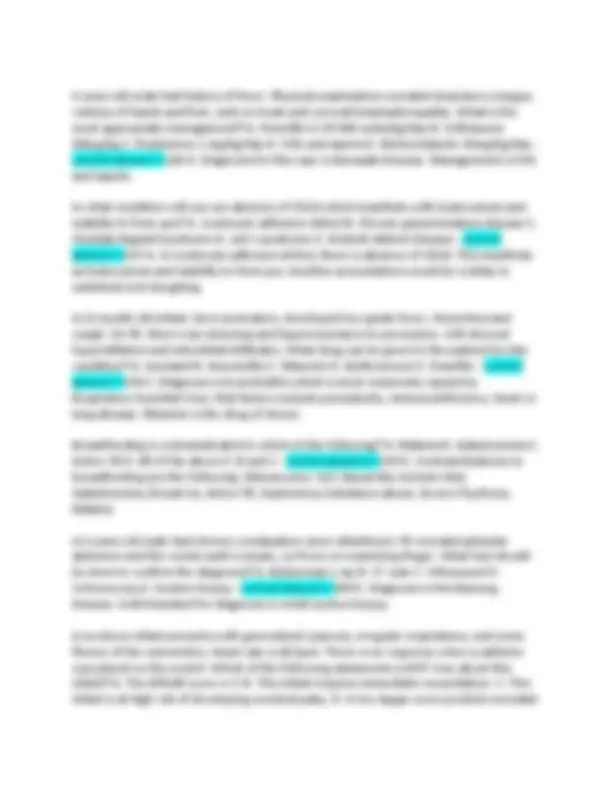



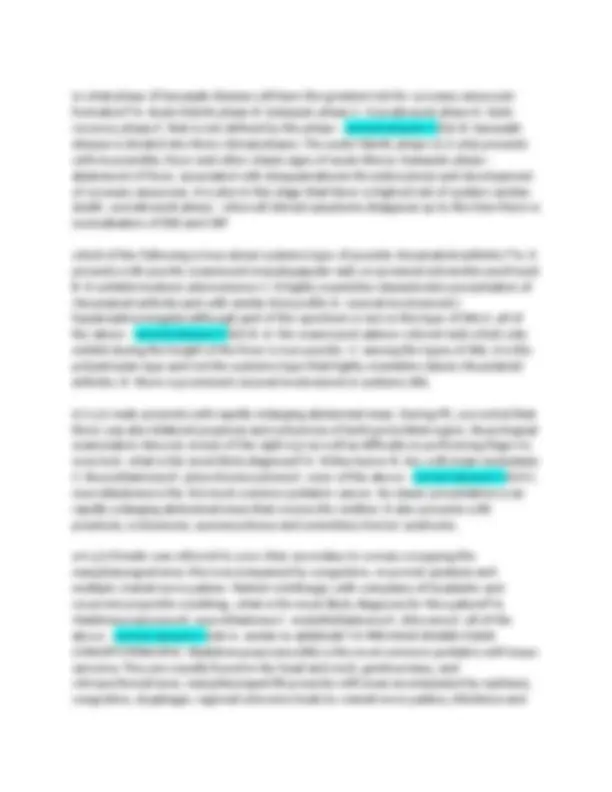
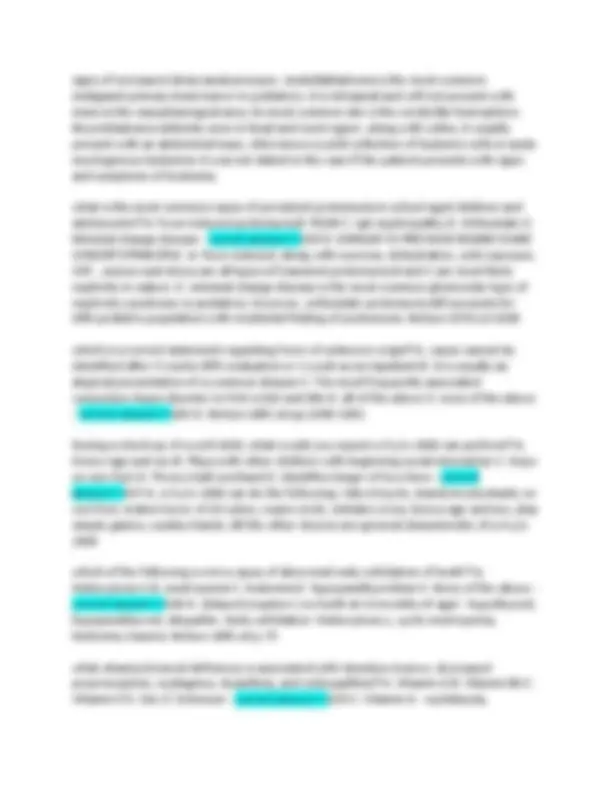
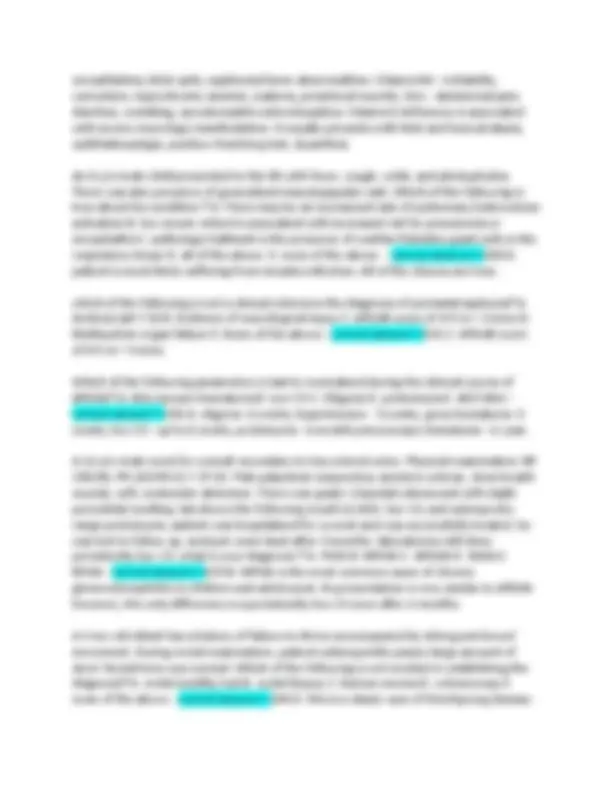
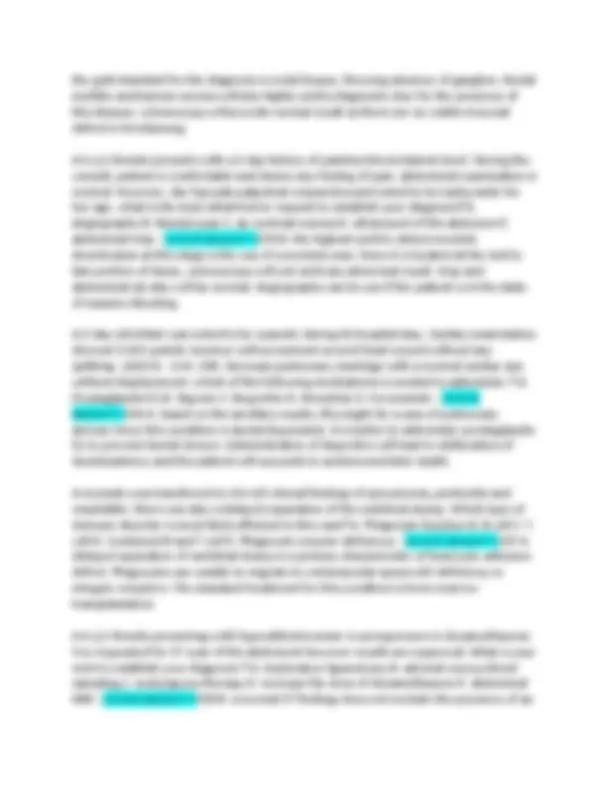
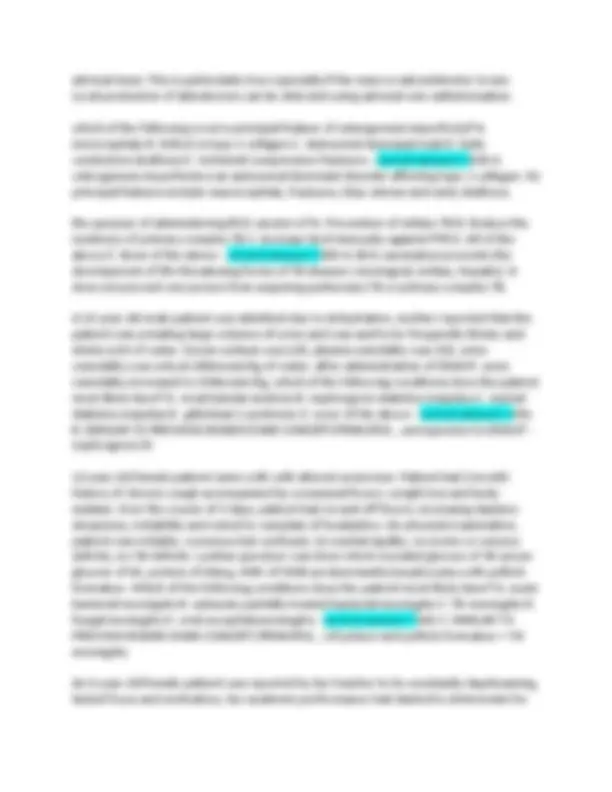
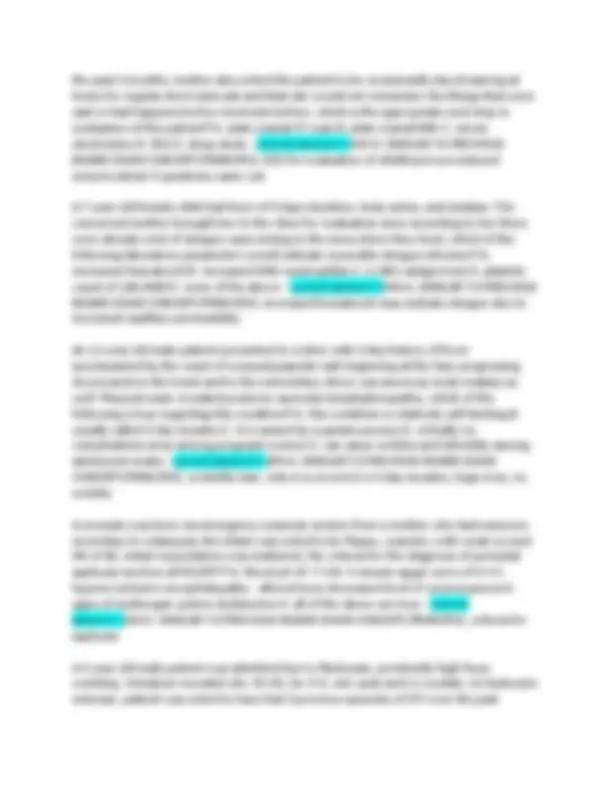

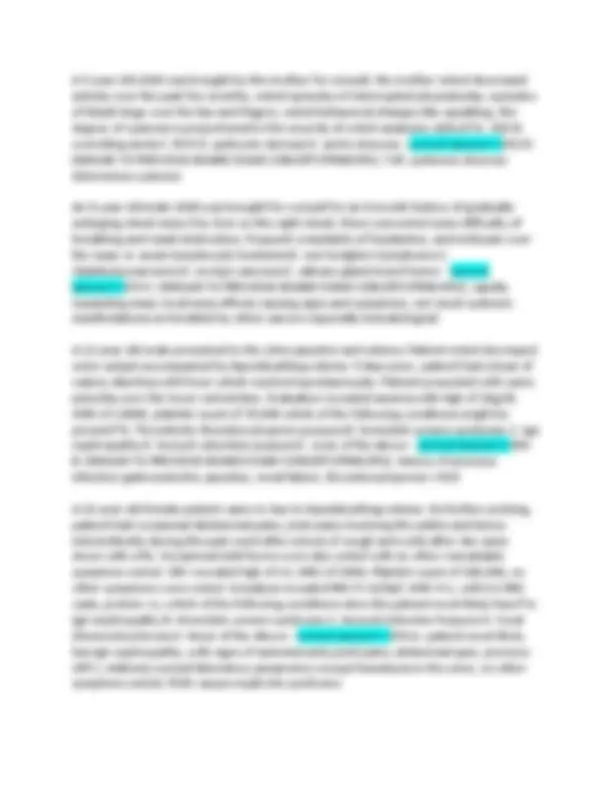


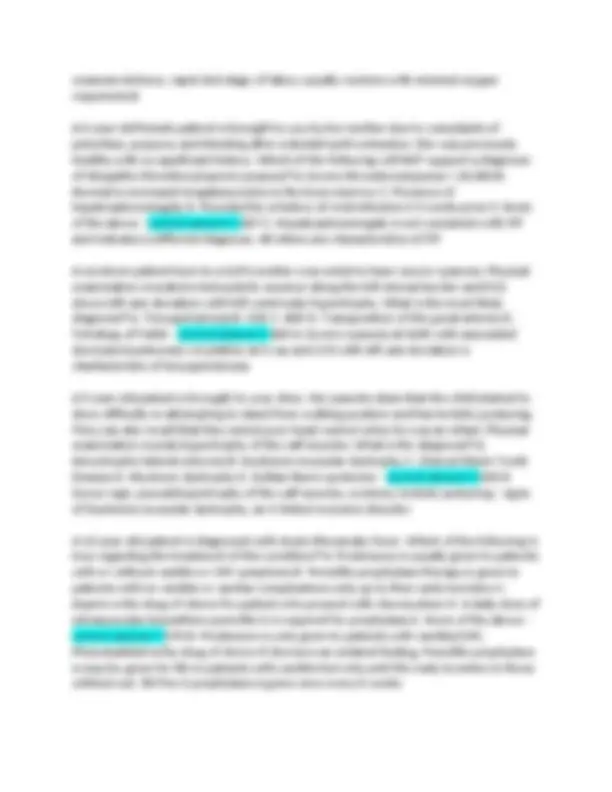


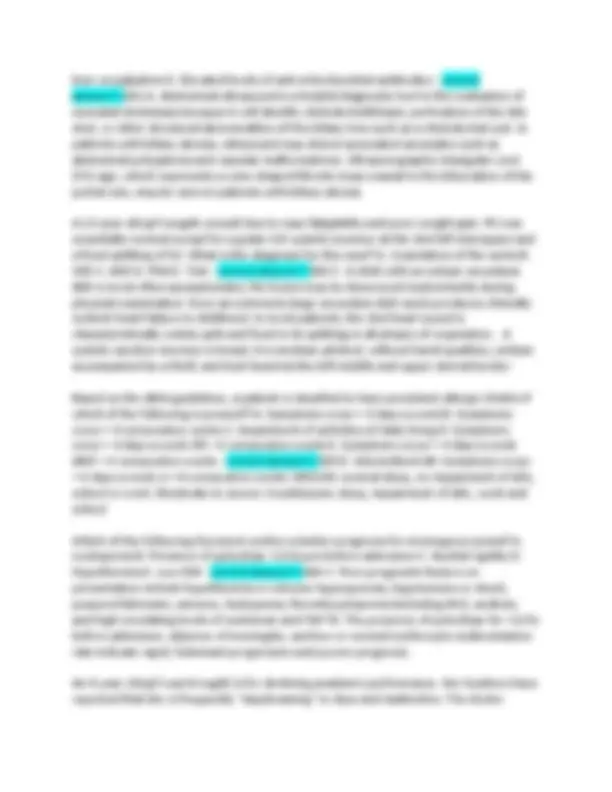

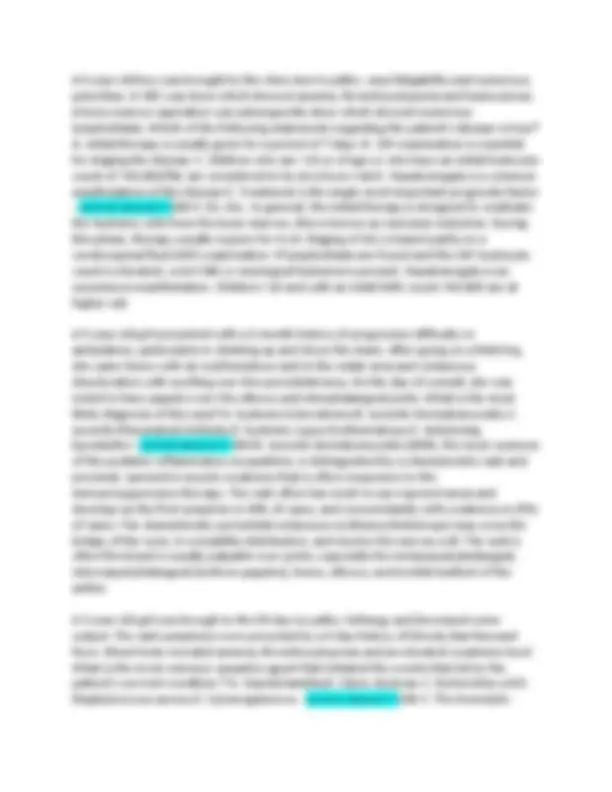

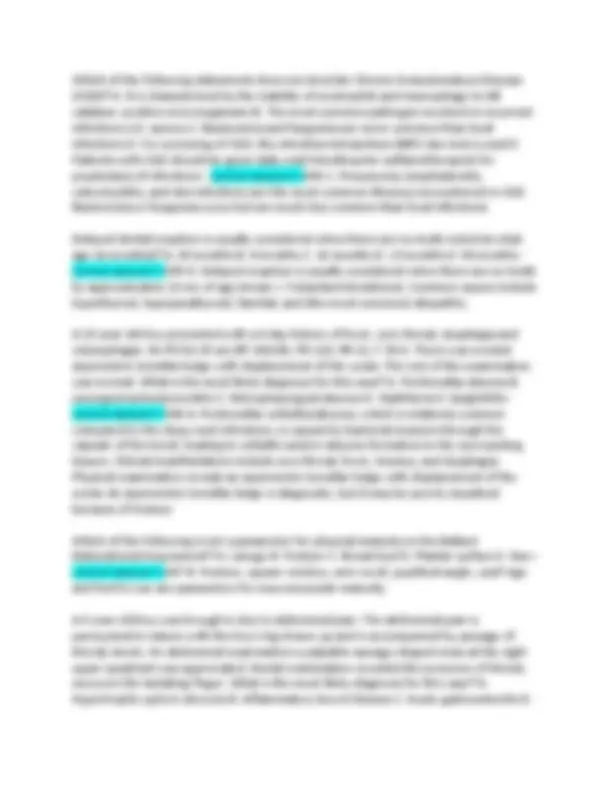

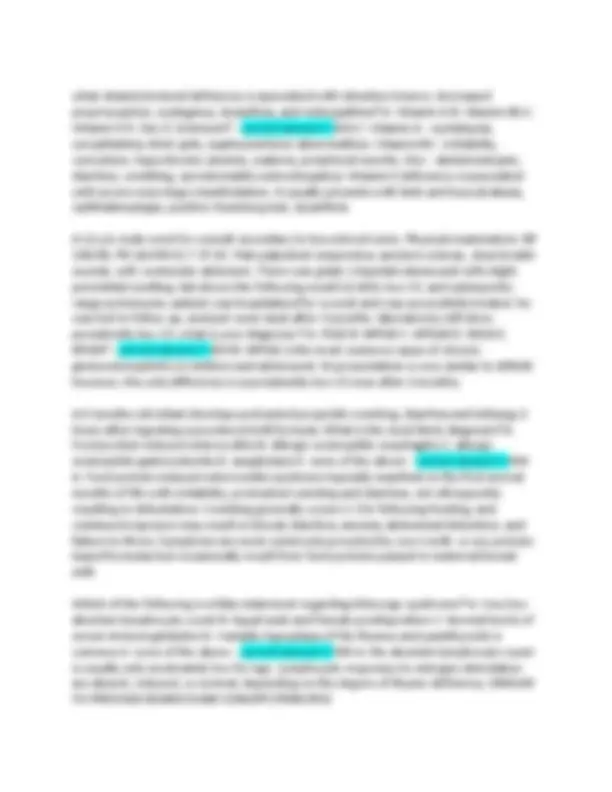






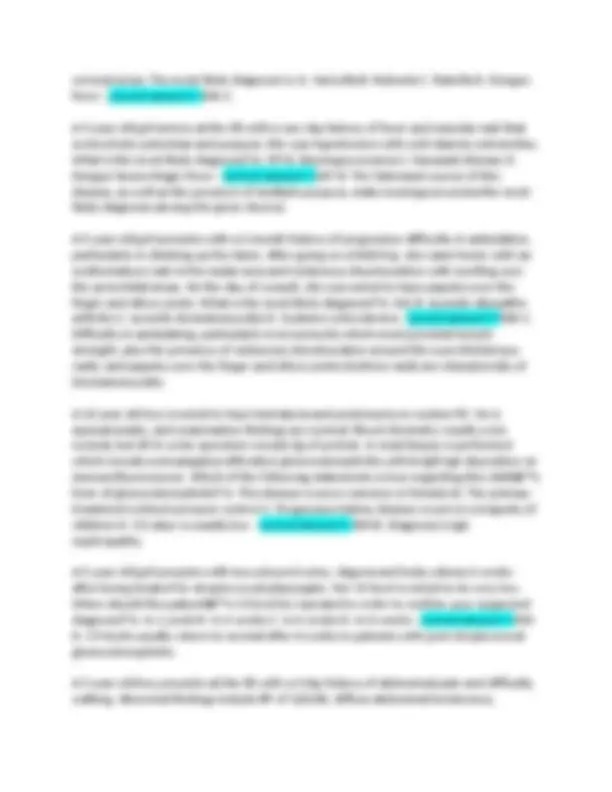




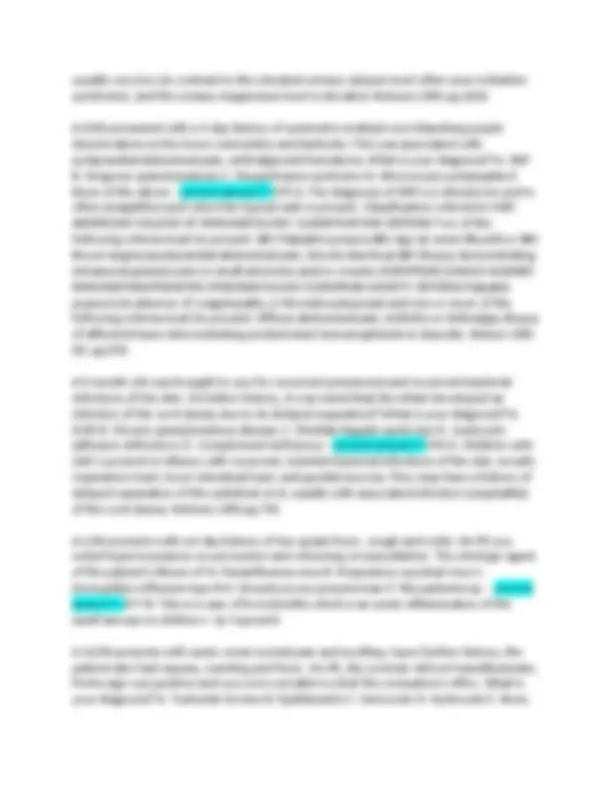




Study with the several resources on Docsity

Earn points by helping other students or get them with a premium plan


Prepare for your exams
Study with the several resources on Docsity

Earn points to download
Earn points by helping other students or get them with a premium plan
Community
Ask the community for help and clear up your study doubts
Discover the best universities in your country according to Docsity users
Free resources
Download our free guides on studying techniques, anxiety management strategies, and thesis advice from Docsity tutors
Which phase of Kawasaki disease is associated with coronary aneurysms? A. Acute febrile phase B. Subacute phase C. Convalescent phase D. Phase of complications E. All of the above - correct answer>>1 B. Kawasaki disease presents with characteristically high, unremitting fever and 4 out of the 5 principal features: Bilateral nonexudative bulbar conjunctival injection with limbal sparing; Erythema of the oral and pharyngeal mucosa with strawberry tongue and dry, cracked lips; Edema and erythema of the hands and feet; Rash of various forms (scarlatiniform, maculopapular, erythema multiforme); Nonsuppurative cervical lymphadenopathy (usually unilateral, with node size >1.5cm). Acute febrile phase - fever and the acute signs of illness and usually lasts 1-2wks Subacute febrile phase - desquamation, thrombocytosis, coronary aneurysms and highest risk of sudden death usually lasts 2 wks Convalescent phase - All clinical signs have disappeared
Typology: Exams
1 / 165

This page cannot be seen from the preview
Don't miss anything!





























































































Which phase of Kawasaki disease is associated with coronary aneurysms? A. Acute febrile phase B. Subacute phase C. Convalescent phase D. Phase of complications E. All of the above - correct answer>>1 B. Kawasaki disease presents with characteristically high, unremitting fever and 4 out of the 5 principal features: Bilateral nonexudative bulbar conjunctival injection with limbal sparing; Erythema of the oral and pharyngeal mucosa with strawberry tongue and dry, cracked lips; Edema and erythema of the hands and feet; Rash of various forms (scarlatiniform, maculopapular, erythema multiforme); Nonsuppurative cervical lymphadenopathy (usually unilateral, with node size >1.5cm). Acute febrile phase - fever and the acute signs of illness and usually lasts 1-2wks Subacute febrile phase - desquamation, thrombocytosis, coronary aneurysms and highest risk of sudden death usually lasts 2 wks Convalescent phase - All clinical signs have disappeared until ESR normalizes typically 6- 8wks after onset on illness Source: Nelson's Textbook of Pediatrics 19th edition p A four year old presents with low-grade fever, intermittent crampy abdominal pain with emesis and swollen knees of 3 days duration. A purpuric rash distributed below the knees of both lower extremities is noted on physical examination. This patient most likely has: A. Meningococcemia B. Idiopathic thrombocytopenic purpura C. Henoch-Scholein purpura D. SLE E. Juvenile Rheumatoid arthritis - correct answer>>2 C.
HSP is a common vasculitis among children and presents with the classic findings of abdominal pain with or without rectal bleeding, vasculitis rash, arthritis and nephritis. The platelet count is normal. Gastrointestinal involvement may progress to intussusception. Source: Nelson's Textbook of Pediatrics 19th edition p A 3 year old female presents with 1 week history of daily (quotidian) fever associated with arthritis of both ankles and her right knee. Her mother notes that she has decreased activity and also notes rashes that come and go in different parts of her body but not on the face. On physical examination, salmon colored patches were noted on the trunk and extremities. Palpation revealed splenomegaly. What is the diagnosis? A. Henoch Schoenlein Purpura B. Systemic Lupus Erythematosus C. Juvenile Rheumatoid arthritis D. Juvenile Dermatomyositis E. Dengue fever - correct answer>>3 C. Don't forget to study rheumatic diseases of childhood even if it's not your favorite topic. Familiarize yourself with the relatively common ones like JRA, SLE and dermatomyositis, HSP and scleroderma. Pay attention to the characteristics of the rash and other features. (Don't fall for the trap of rash + arthritis = SLE.. It's not always SLE!) JRA - Salmon colored patch, evanescent, spares the face SLE - Malar rash, photosensitive Dermatomyositis - heliotrope (periorbital) rash, gottron papules (rash on the knuckles) HSP - purpura in dependent portions For JRA, know the differences between subtypes (oligoarticular vs polyarticular vs systemic onset) This case in particular is a case of systemic onset Juvenile Rheumatoid arthritis (also called Still's Disease) Source: Nelson's Textbook of Pediatrics 19th edition p A 4 yr old boy presents with his third episode of painful cervical lymphadenitis. Each was treated with incision and drainage and grew S. aureus. He also experiences recurrent skin infections. A year ago, he was hospitalized for osteomyelitis. The most important laboratory test is:
Mild-moderate (no impairment) or severe (with impairment of daily living/sleep) Source: Nelson's Textbook of Pediatrics 19th edition p The Kasai procedure is indicated for which of the following? A. Neonatal hepatitis B. Biliary atresia C. Metabolic liver disease D. Fulminant hepatic failure E. None of the above - correct answer>>7 B. Despite initial success of the Kasai operation, patients with biliary atresia eventually get liver transplantation. Source: Nelson's Textbook of Pediatrics 19th edition 1387 An 8 month old manifests with fussiness and emesis and refuses to eat. 1 week ago, he was brought for consult and was diagnosed with URTI. On the morning of consult, his mother noted currant jelly like material on his diaper. On PE, a sausage shaped mass was palpable in the abdomen. There is likewise abdominal distention and rectal exam reveals blood in the stool. The most likely diagnosis is: A. Viral diarrhea B. Duodenal atresia C. Intussusception D. Hypertrophic pyloric stenosis E. Intestinal adenoma - correct answer>>8 C. Aside from that, intussusception may present with lethargy out of proportion to the intestinal signs and symptoms. Intussusception in children is usually due to lymphoid hyperplasia in the intestines. This becomes the lead point. The most common location is ileocolic. Source: Nelson's Textbook of Pediatrics 19th edition p A 3 year old female presents to your office with unilateral nasal discharge. The discharge is described by the caretaker to be malodorous and lately has been blood tinged. The most likely diagnosis is: A. Tertiary syphilis B. Unilateral choanal atresia C. Nasopharyngeal carcinoma
D. Foreign body E. Angiosarcoma of the nose - correct answer>>9 D. Source: Nelson's Textbook of Pediatrics 19th edition p 1431 A 3 year old is brought to the ER. On PE, inspiratory stridor and a barking cough were noted. There is mild respiratory distress, tachypnea, and fever. The signs and symptoms are aggravated by agitation and crying. The most likely diagnosis is A. Tracheomalacia B. Laryngotracheobronchitis C. Epiglottitis D. Bacterial tracheitis E. Peritonsillar abscess - correct answer>>10 B. This is a case of croup and is common in this age group. Barking cough = croup Epiglotitis and bacterial tracheitis patients are more toxic appearing and not in merely mild respiratory distress Source: Nelson's Textbook of Pediatrics 19th edition p A newborn was noted to be cyanotic. Unfortunately the imaging facilities are unavailable for the day. A hyperoxia test was thus done which showed no improvement of PaO2 after administration of 100% O2. The next step in the management of this neonate is: A. Low tidal volume mechanical ventilation B. Positive pressure ventilation C. Digoxin D. Emergency laparotomy E. Prostaglandin E - correct answer>>11 E. The hyperoxia test is used to differentiate whether the etiology of cyanosis is cardiac or not. PaO2 does not improve in cardiac etiologies. In the absence of imaging for definitive diagnosis of the congenital heart disease, the clinician should not hesistate to administer prostaglandin in case the patient has a ductus dependent congenital heart disease. Prostaglandin prevents the ductus from closing. Source: Nelson's Textbook of Pediatrics 19th edition p
E. Evan's syndrome - correct answer>>14 C. McCune Albright syndrome - polyostotic fibrous dysplasia, cafe-au-lait skin pigmentation, autonomous endocrine hyperfunction Mafucci syndrome - Multiple enchondromas and hemangiomas Evan's syndrome - autoimmune anemia + thrombocytopenia Source: Nelson’s Textbook of Pediatrics 19th edition p A previously healthy 8 year old male presents with progressive painless proptosis and decreased visual acuity of the left eye during the past 10 weeks. The most likely diagnosis is: A. Orbital cellulitis B. Trichinosis C. Retinoblastoma D. Rhabdomyosarcoma E. None of the above - correct answer>>15 D. Rhabdomyosarcoma is the most common sarcoma of childhood. Orbital rhabdomyosarcoma is a common site for rhadomyosarcoma which produces local signs as it grows and displaces normal tissues. Retinoblastoma may be endophytic or exophytic from the retina. They present with leukocoria or strabismus. Source: Nelson's Textbook of Pediatrics 19th edition p1761, 1768 A 4 year old male experienced an upper respiratory tract infection that was followed in 2 weeks by generalized edema. His blood pressure is normal. Urinalysis reveals 2- 5 rbc/hpf and 4+ protein. His BUN is 19mg/dl. Serum albumin 0.9g/dl and C3 was 93mg/dl. The most likely diagnosis is: A. Post streptococcal glomerulonephritis B. Membranous glomerulonephritis C. Minimal change disease D. Focal sclerosis E. IgA nephropathy - correct answer>>16 C. Patient is presenting with nephrotic syndrome. The most common of which is minimal change disease in children.
Hypoalbuminemia, proteinuria, edema and hyperlipidemia constitute the nephrotic syndrome. Source: Nelson's Textbook of Pediatrics 19th edition p The following listed phrases are characteristics of simple partial seizures EXCEPT: A. Loss of consciousness B. Duration of 10-20 sec C. Versive seizures D. May have secondary generalization E. Abnormal EEG - correct answer>>17 A. There is never a loss of consciousness in simple partial seizures. Some patients may actually be conversant and talk to you during the event. Source: Nelson's Textbook of Pediatrics 19th edition p Pincer grasp is usually noted at what age? A. 2 mos B. 4 mos C. 6 mos D. 8 mos E. 10 mos - correct answer>>18 D. Pincer grasp/thumb finger grasp Source: Nelson's Textbook of Pediatrics 19th edition p A 12 year old male presents with complaints of polyarthritis and an evanescent rash which spares the face. On PE, patient appears to be in respiratory distress and auscultation revealed tachycardia and a gallop rhythm, and some hard painless freely movable swellings over the extensor surfaces like the elbows. Chest x-ray reveals cardiomegaly and ASOT is 350 Todd units. The following are appropriate in the management of this patient except: A. Penicillin V 200-500mg QID x 1 week B. Complete bed rest C. Morphine D. Digoxin E. O2 supplementation - correct answer>>19 A.
A 7-year-old boy presents with palpable purpura on the buttocks and legs, fever, abdominal pain and vomiting, arthritis in his knees and ankles, melena, and hematuria. His mother states that he had an upper respiratory illness approximately 1 week ago, but has otherwise been well. Blood tests reveal mild renal insufficiency. The most likely cause of the bleeding into the skin observed in this patient is A. coagulation factor deficiency B. qualitative platelet dysfunction C. quantitative platelet dysfunction D. vasculitis E. vitamin deficiency - correct answer>>22 D. The clinical description is that of Henoch-Schonlein purpura, a form of leukocytoclastic angiitis (hypersensitivity vasculitis) resulting from an immune reaction that damages the vascular endothelium. Henoch-Schonlein purpura is closely related to IgA nephropathy, a glomerulopathy resulting in nephritic syndrome, and may represent a systemic version of this disease. A mother calls you frantic because she has just been diagnosed with varicella (chicken pox). She delivered a term infant 7 days ago that appears to be eating, stooling, and urinating without difficulty. The child has been afebrile and seems to be doing well. Which of the following is the most appropriate step in management? A. Isolate the infant from the mother. B. Hospitalize the infant in the isolation ward. C. Administer acyclovir to the infant. D. Administer varicella-zoster immunoglobulin to the infant. E. Advise the mother to continue regular well-baby care for the infant. - correct answer>>23 E. Per CDC recommendations, varicella-zoster immunoglobulin (VZIG) should be administered to the infant immediately after delivery if the other had the onset of varicella within 5 days prior to delivery, and immediately upon diagnosis if her chicken pox started within 2 days after delivery. If untreated, about half of these infants will develop serious varicella as early as 1 day of age. If a normal full-term newborn is exposed to chicken pox 2 or more days postnatally, VZIG and isolation are not necessary because these babies appear to be at no greater risk for complications than older children.
Acyclovir may be used in infants at risk for severe varicella, such as those infants exposed perinatally. A 10-month-old baby boy has a 5-hour history of intermittent crying, and with intermittent drawing up of his knees to his chest in between crying episodes. On the way to the emergency room he passes a loose, bloody stool. He has had no vomiting and has refused his bottle since the crying began. Physical examination is noteworthy for an irritable infant whose abdomen is very difficult to examine because of constant crying. His temperature is 38.8°C (101.8°F). The rectal ampulla is empty, but there is some gross blood on the examining finger. Which of the following studies would be most helpful in the immediate management of this patient? A. Stool culture B. Examination of the stool for ova and parasites C. Air contrast enema D. Examination of the blood smear E. Coagulation studies - correct answer>>24 C. The usual presentation of intussusception is that of an infant between 4 and 10 months of age who has a sudden onset of intermittent colicky abdominal pain. The child can appear normal when the pain abates, but as it recurs with increasing frequency, the child can begin to vomit and become progressively more obtunded. The passage of stool containing blood and mucus, frequently described as resembling currant jelly, is often observed. Early examination of the abdomen can be unremarkable, but as the problem persists, a sausage-shaped mass in the right upper quadrant is frequently palpated. An air, barium, or saline enema examination under fluoroscopic or ultrasound control can be therapeutic as well as diagnostic when the hydrostatic effects of the contrast serve to reduce the intussusception, but should be performed with surgical backup, as a complication of attempted reduction is intestinal perforation. Rates of intestinal perforation are lowest with air reduction. Early diagnosis prevents bowel ischemia. The cause of most intussusceptions is unknown, but a Meckel diverticulum or polyp can serve as a lead point. None of the other choices would result in a correct diagnosis (and potential therapy) for the child with a classic presentation for intussusception. A 13-year-old boy presents to the pediatrician with extrapyramidal signs, including a resting and kinetic tremor. An ophthalmologic examination demonstrates the presence of dark rings that appear to encircle the iris of the eye, and his laboratory studies demonstrate elevated liver enzymes. It is likely that the patient's condition is associated with the accumulation of A. Copper B. Councilman bodies C. Eosinophilic hyaline inclusions
Patients initially present toward the end of a viral infection with sleepiness, emesis, and abnormal liver functions. As the disease progresses, the patient may develop seizures, coma, hyperventilation, and decorticate posturing. Ultimately they may develop respiratory arrest, loss of deep tendon reflexes (DTRs), and fixed and dilated pupils. Death is usually from cerebral edema and subsequent herniation. While aspirin is no longer routinely used in children as an antipyretic or pain reliever, the increase in the use of aspirin in adults with heart disease requires specific counseling for parents of children with influenza and varicella to avoid aspirin use. In addition, both of these infections are preventable with proper immunization. N-acetylcysteine is protective of hepatocytes in acetaminophen overdose. A 4-year-old boy in your practice has been having many infections. You suspect that he may have an immune dysfunction. Quantitative immunoglobulins were sent and were normal. Which of the following immunodeficiency disorders is associated with normal immunoglobulin G (IgG) levels? A. X-linked agammaglobulinemia B. DiGeorge syndrome C. Late-onset hypogammaglobulinemia D. Ataxia-telangiectasia E. Severe combined immunodeficiency - correct answer>>27 B. Although reduced levels of immunoglobulin A (IgA) or IgE may be seen in patients with DiGeorge syndrome (T cell deficiency disorder), the total serum immunoglobulin level usually is normal and IgG levels are normal In X-linked agammaglobulinemia (Bruton's) and late-onset hypogammaglobulinemia, IgG, IgM, and IgA levels are all reduced, and the total immunoglobulin level is less than 100 mg/dL. Patients with ataxia-telangiectasia have a defect in their DNA repair mechanism. One of the clinical features is low IgA and IgG. Severe combined immunodeficiency results in a decrease in all immunoglobulins. A 5-month-old child was normal at birth, but the family reports that the child does not seem to look at them any longer. They also report the child seems to startle more easily
than he had before. Testing of his white blood cells (WBCs) identifies the absence of hexosaminidase A activity, confirming the diagnosis of which of the following? A. Niemann-Pick disease, type A B. Infantile Gaucher disease C. Tay-Sachs disease D. Krabbe disease E. Fabry disease - correct answer>>28 C. There were 2 questions about Tay-Sachs in our Pediatric Exam. Children who have Tay-Sachs disease are characterized by progressive developmental deterioration; physical signs include macular cherry-red spots and exquisite and characteristic sensitivity to noise. Diagnosis of this disorder can be confirmed biochemically by the absence of hexosaminidase A activity in WBCs. The other GM2 gangliosidosis, Sandhoff disease, results from a deficiency of both hexosaminidase A and B. Tay-Sachs disease is inherited as an autosomal recessive trait; frequently, affected children are of Eastern European Jewish ancestry. The other disorders listed in the question are associated with enzyme deficiencies as follows: Niemann-Pick disease (type A), sphingomyelinase, which results in a normal-appearing child at birth who then develops hepatosplenomegaly, lymphadenopathy, and psychomotor retardation in the first 6 months, followed by regression after that; Infantile Gaucher disease (type II Gaucher), glucosidase, which presents in infancy with increased tone, strabismus, organomegaly, failure to thrive, strider, and several years of psychomotor regression before death; Krabbe disease (globoid cell leukodystrophy), galactocerebroside-galactosidase, which presents early in infancy with irritability, seizures, hypertonia, and optic atrophy, with severe delay and death usually occurring in the first 3 years of life; Fabry disease, alpha-galactosidase, which presents in childhood with angiokeratomas in the bathing trunk area, ultimately resulting in severe pain episodes.
A diet free from branched-chain amino acids would be appropriate for maple syrup urine disease. Part of the treatment for a patient with homocystinuria is high doses of vitamin B6. A 2-year-old child is admitted to your hospital. The child's pediatrician has been following the child for several days and has noted her to have had high fever, peeling skin, abdominal pain, and a bright red throat. You are concerned because two common pediatric problems that could explain this child's condition have overlapping presenting signs and symptoms. Which of the following statements comparing these two diseases in your differential is true? A. Neither has a cardiac complication. B. Serologic tests are helpful in diagnosing both. C. Only one of the diseases has mucocutaneous and lymph node involvement. D. Pharyngeal culture aids in the diagnosis of one of the conditions. E. A specific antibiotic therapy is recommended for one of the conditions, but only supportive care is recommended for the other. - correct answer>>30 D. The two conditions in consideration are Kawasaki disease and scarlet fever caused by a group A beta-hemolytic streptococci (GABHS). Kawasaki disease is an acute febrile illness of unknown etiology and shares many of its clinical manifestations with scarlet fever. Scarlatiniform rash, desquamation, erythema of the mucous membranes that produces an injected pharynx and strawberry tongue, and cervical lymphadenopathy are prominent findings in both. The most serious complication of Kawasaki disease and scarlet fever is cardiac involvement. Erythrogenic toxin-producing group A beta- hemolytic streptococci is the agent responsible for scarlet fever. Isolation of the organism from the nasopharynx and a rise in antistreptolysin titers will confirm the diagnosis. Serologic tests for a variety of infectious agents, both viral and bacterial, have been negative in Kawasaki disease. Rheumatic heart disease is a serious sequela of streptococcal pharyngitis, which can be prevented by appropriate treatment with penicillin. Coronary artery aneurysm and thrombosis are the most serious complications of Kawasaki disease. The current approach to treatment of Kawasaki disease, which includes specific therapy with aspirin and gamma-globulin administered within a week
of the onset of fever, appears to lower the prevalence of coronary artery dilatation and aneurysm to shorten the acute phase of illness A 3-year-old girl presents with generalized edema shortly after recovery from an upper respiratory infection. Laboratory studies reveal marked albuminuria, as well as hypoalbuminemia and hyperlipidemia. Prior similar episodes responded to steroids. The most likely diagnosis is A. FSGS B. membranous GN C. lipoid nephrosis D. PSGN E. RPGN - correct answer>>31 C. Our Pediatrics exam featured numerous renal pathology questions as the stem case. It is therefore essential to nail the diagnosis at the start to keep you on track for the next questions. The combination of generalized edema, massive proteinuria, hypoalbuminemia, and hyperlipidemia constitutes the nephrotic syndrome, the prototype of which is minimal change disease (lipoid nephrosis). This disorder characteristically occurs in young children and demonstrates intracytoplasmic lipid in the proximal convoluted tubules, a paucity of glomerular abnormalities by light microscopy, and fusing (absence) of the epithelial foot processes by electron microscopy. 4 - year-old boy develops weakness of proximal lower back and extremity muscles, manifested by lordosis, a waddling gait, and the need to push on his knees in order to stand. Examination reveals proximal muscle weakness and bilateral enlargement of the calves. His younger brother has begun to display similar findings, as has his older half- brother, who has the same mother. Serum CK is markedly elevated. Which of the following is characteristic of this disorder? A. Aberrant protein coded by a very small gene sequence on the Y chromosome B. Autosomal dominant mode of inheritance C. Mitochondrial inheritance D. Regression of findings in late adolescence and adult life E. Total absence or marked decrease of an important gene product - correct answer>>32 E. The clinical picture is that of Duchenne muscular dystrophy, the most common and most severe of the muscular dystrophies. This X-linked disorder is characterized by failure of synthesis of dystrophin, most often because of deletion of one or many exons in the DMD gene. Patients manifest with proximal muscle weakness, progressing to muscle necrosis. Serum CK is markedly increased. Compensatory hypertrophy is
disorder is an aggressive B-cell non-Hodgkin ymphoma most commonly affecting children. The endemic (African) form is characterized by the involvement of the maxilla or mandible, whereas the sporadic (Western) form usually involves the abdominal organs. Burkitt lymphoma is generally a rapidly growing neoplasm, and the endemic form has a frequent association with EBV. A 2-year-old boy presents with his third bone fracture within the past several months. There is no history or evidence of trauma. Several close family members have been similarly affected. The child is small for his age, and the sclerae are tinged a bluish color. Radiographs reveal generalized osteopenia and evidence of multiple fractures, both old and new. Which of the following is the usual mode of inheritance of this disorder? A. Autosomal dominant B. Autosomal recessive C. X-linked dominant D. X-linked recessive E. Mitochondrial - correct answer>>35 A. Osteogenesis imperfecta (or brittle bone disease) is an autosomal dominant disorder characterized by multiple fractures with minimal trauma. It is caused by mutations in either of the genes that code for type I collagen and is manifested by connective tissue abnormalities affecting the bones, teeth, skin, and eyes. The sclerae can appear blue due to translucency of the thin connective tissue overlying the choroid. The disorder occurs in several variants defined by the age of onset and the severity of the fractures. In the less obvious cases, the principal differential diagnostic consideration is child abuse. A fully immunized 2-year-old presents to the emergency room with several days of low- grade fever, barking cough, and noisy breathing. Over the past few hours he has developed a fever of 40°C (104°F) and looks toxic. He has inspiratory and expiratory stridor. The family has not noticed drooling, and he seems to be drinking without pain. Direct laryngoscopy reveals a normal epiglottis. The management of this disease process includes which of the following? A. Intubation and intravenous antibiotics B. Inhaled epinephrine and oral steroids C. Intravenous methylprednisolone D. Observation in a cool mist tent E. Oral antibiotics and outpatient follow-up - correct answer>>36 A.
Bacterial tracheitis is an uncommon but severe and life-threatening sequela of viral laryngotracheobronchitis. The typical story is that presented in the case, with several days of viral upper respiratory symptoms, followed by an acute elevation of temperature and an increase in respiratory distress. Inspiratory stridor is typical in croup; the biphasic stridor and high fever in this patient should be a clue to consider alternative diagnoses. Children may also present acutely and without the initial viral symptoms. The differential must include epiglottitis; the lack of drooling and dysphagia (and the rarity of epiglottitis since the introduction of the Haemophilus influenza B vaccine) help make this a case of tracheitis. Management for tracheitis includes establishing an airway with endotracheal intubation and IV antibiotics. Special attention is focused on preservation of the airway, as even intubated children with tracheitis can have secretions thick and copious enough to occlude the airway. Oral antibiotics and outpatient follow-up for a patient with respiratory distress and toxic appearance are never appropriate. Inhaled epinephrine and oral steroids as well as observation in a cool mist tent suggest a diagnosis of croup, a disease that presents without high fever but with inspiratory stridor a few days after an upper respiratory infection. In the case presentation, the fever and toxic appearance differentiate this condition from viral croup. Intravenous methylprednisolone is a component of treatment for asthma, a diagnosis unlikely in a patient with high fever as outlined. A 15-year-old athlete with knee pain and severe point tenderness at the tibial tubercle most likely has A. Osgood-Schlatter disease B. Legg-Calve-Perthes disease C. Slipped capital femoral epiphysis (SCFE) D. Tibial torsion E. Charcot-Marie-Tooth Disease - correct answer>>37 A. Osgood-Schlatter disease is a very common problem most often seen in athletically active adolescents. This disorder is characterized by ossification in the distal patellar tendon at the point of its insertion onto the tibial apophysis. This disorder is thought to